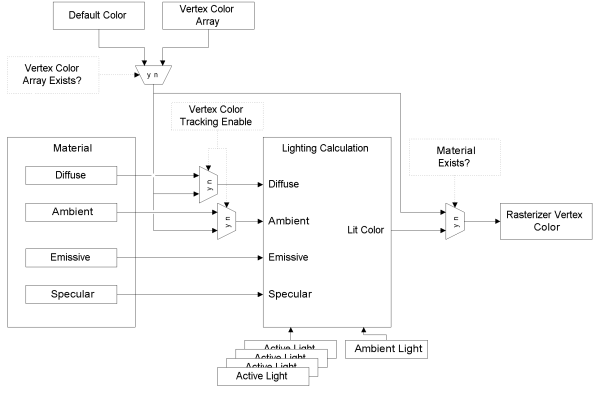
|
JSR-184 Public Review Draft - Apr. 30, 2003. | ||||||||||
| PREV CLASS NEXT CLASS | FRAMES NO FRAMES | ||||||||||
| SUMMARY: NESTED | FIELD | CONSTR | METHOD | DETAIL: FIELD | CONSTR | METHOD | ||||||||||
java.lang.Object
|
+--javax.microedition.m3d.Object3D
|
+--javax.microedition.m3d.Material
An Appearance component encapsulating material attributes for lighting computations.
Other attributes required for lighting are defined in Light, World,
GeometryMode, and VertexBuffer.
The diagram below illustrates how the final, lit color is obtained for a vertex.
Lighting is disabled for a submesh if it has a null Material, and enabled otherwise.
If lighting is disabled, the final vertex color is taken from the associated VertexBuffer
as such. If lighting is enabled, the final color is computed according to the OpenGL 1.3
lighting equation (p. 48), using the material colors specified here. Finally, if vertex
color tracking is enabled, the the AMBIENT and DIFFUSE material
colors are replaced with the per-vertex (or default) color from the VertexBuffer.

Lighting is computed according to the OpenGL 1.3 specification, section 2.13.1, with the following exceptions:
AMBIENT_AND_DIFFUSE;The color that is set in Light corresponds to both the diffuse intensity
dcli and the specular intensity
scli in the lighting equation.
Thus, the diffuse and specular components can not be set separately,
and the ambient component is fixed to zero. The global ambient light
(specified in World or Graphics3D) corresponds to the light model
ambient acs in the equation.
| Field Summary | |
static int |
AMBIENT
A parameter for setColor and getColor, specifying
that the ambient color component is to be set or retrieved. |
static int |
DIFFUSE
A parameter for setColor and getColor, specifying
that the diffuse color component is to be set or retrieved. |
static int |
EMISSIVE
A parameter for setColor and getColor, specifying
that the emissive color component is to be set or retrieved. |
static int |
SPECULAR
A parameter for setColor and getColor, specifying
that the specular color component is to be set or retrieved. |
| Fields inherited from class javax.microedition.m3d.Object3D |
userObject |
| Constructor Summary | |
Material()
Creates a Material object with default values. |
|
| Method Summary | |
int |
getColor(int target)
Gets the value of the specified color component of this Material. |
float |
getShininess()
Gets the current shininess of this Material. |
boolean |
isVertexColorTrackingEnabled()
Queries whether vertex color tracking is enabled. |
void |
setColor(int target,
int ARGB)
Sets the given value to the specified color component(s) of this Material. |
void |
setShininess(float shininess)
Sets the shininess of this Material. |
void |
setVertexColorTrackingEnable(boolean enable)
Enables or disables vertex color tracking. |
| Methods inherited from class javax.microedition.m3d.Object3D |
addAnimationTrack, animate, clone, find, getAnimationTrack, getAnimationTrackCount, getReferences, getUserID, removeAnimationTrack, setUserID |
| Methods inherited from class java.lang.Object |
equals, getClass, hashCode, notify, notifyAll, toString, wait, wait, wait |
| Field Detail |
public static final int AMBIENT
A parameter for setColor and getColor, specifying
that the ambient color component is to be set or retrieved.
public static final int DIFFUSE
A parameter for setColor and getColor, specifying
that the diffuse color component is to be set or retrieved.
public static final int EMISSIVE
A parameter for setColor and getColor, specifying
that the emissive color component is to be set or retrieved.
public static final int SPECULAR
A parameter for setColor and getColor, specifying
that the specular color component is to be set or retrieved.
| Constructor Detail |
public Material()
Creates a Material object with default values. The default values are:
Note that even though the alpha component can be set for all color components, it is ignored for all but the diffuse component.
| Method Detail |
public void setColor(int target,
int ARGB)
Sets the given value to the specified color component(s) of this Material. The color components to set are specified as an inclusive OR of one or more of the symbolic constants listed above. The color is given in ARGB format, but the alpha component is ignored for all but the diffuse color.
target - a bitmask of color component identifiersARGB - color for the target property (or properties) in 0xAARRGGBB format
java.lang.IllegalArgumentException - if target has a value
other than an inclusive OR of one or more of AMBIENT,
DIFFUSE, EMISSIVE, SPECULARgetColorpublic int getColor(int target)
Gets the value of the specified color component of this Material. The alpha component of the returned value is guaranteed to be zero for all but the diffuse color component.
target - exactly one of AMBIENT, DIFFUSE, EMISSIVE, SPECULAR
java.lang.IllegalArgumentException - if target has a value
other than one of those listed abovesetColorpublic void setShininess(float shininess)
Sets the shininess of this Material. Shininess is the specular exponent term in the lighting equation, and it can take on values between [0, 128]. Larger values of shininess will make specular highlights more concentrated, and smaller values will make them more spread out.
shininess - the specular exponent value to set for this Material
java.lang.IllegalArgumentException - if shininess is not in [0, 128]getShininesspublic float getShininess()
Gets the current shininess of this Material.
setShininesspublic void setVertexColorTrackingEnable(boolean enable)
Enables or disables vertex color tracking. When enabled, the AMBIENT
and DIFFUSE material colors will take on color values from the associated
VertexBuffer on a per-vertex basis. The ambient and diffuse color values of this
Material are ignored in that case.
enable - true to turn vertex color tracking on; false to turn it offpublic boolean isVertexColorTrackingEnabled()
Queries whether vertex color tracking is enabled.
|
JSR-184 Public Review Draft - Apr. 30, 2003. | ||||||||||
| PREV CLASS NEXT CLASS | FRAMES NO FRAMES | ||||||||||
| SUMMARY: NESTED | FIELD | CONSTR | METHOD | DETAIL: FIELD | CONSTR | METHOD | ||||||||||